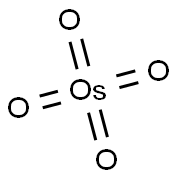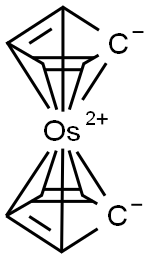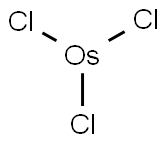OSMIUM
Synonym(s):OS006010
- CAS NO.:7440-04-2
- Empirical Formula: Os
- Molecular Weight: 190.23
- MDL number: MFCD00011147
- EINECS: 231-114-0
- SAFETY DATA SHEET (SDS)
- Update Date: 2025-01-27 09:38:02

What is OSMIUM?
Description
Osmium is silvery white, hard transition metals with a high melting point. osmium is one of the rarest elements on earth.
Chemical properties
Bluish-white lustrous metal; brittle and fairly hard; close-packed hexago- nal crystal system; density 22.48 g/cm3; Moh’s hardness 7.0; melts at about 3,050°C; vaporizes above 5,300°C; electrical resistivity 8.12 microhms-cm at 0°C; Young’s modulus 4.0x104 tons/in2; magnetic susceptibility 0.052x10–6 cm3/g; thermal neutron absorption coefficient 15 barns; insoluble in water; insoluble in HCl and H2SO4; slightly soluble in nitric acid and aqua regia; insoluble in ammonia; solubilized by fusion with caustic soda and sodium peroxide or caustic soda and potassium chlorate and the mass dissolved in water.
Chemical properties
Osmium is a blue-white metal. It is found in platinum ores and in the naturally occurring alloy osmiridium. Osmium when heated in air or when the finely divided form is exposed to air at room temperature, oxidizes to form the tetroxide (OsO4), osmic acid. Osmium tetraoxide is a colorless, crystalline solid or pale-yellow mass. Unpleasant, acrid, chlorine-like odor. A liquid above 41°C.
Physical properties
One of the important properties of osmium is the formation of gases when the metal isexposed to air. These fumes are extremely toxic, which limits osmium’s usefulness. Osmium is ahard, tough, brittle, bluish-white metal that is difficult to use except in a powder form that oxidizesinto osmium tetroxide (OsO4), which not only has objectionable odor but also is toxic.
Osmium has a relatively high melting point of 3,054°C and a boiling point of 5,500°C,with a density of 22.61 g/cm3.
Isotopes
Osmium has 41 isotopes, five of which are stable. Two are naturally radioactiveisotopes with very long half-lives. Following are the stable isotopes and their contributionto the element’s natural existence in the Earth’s crust: Os-187 = 1.6%, Os-188 =13.29%, Os-189 = 16.21%, Os-190 = 26.36%, and Os-192 = 40.93%. The remain ing percentage of the element on Earth is in the form of the two naturally radioactiveisotopes: Os-184 = 0.02% and Os-186 = 1.59%. All the other isotopes of osmium areradioactive and artificially produced in nuclear reactors and particle accelerators.
Origin of Name
Its name is derived from the Greek word osme, meaning “odor” or “smell,” because of the element’s objectionable smell when it is first isolated from platinum ores using aqua regia.
Occurrence
Osmium is the 80th most abundant element on Earth. As a metal, it is not found free innature and is considered a companion metal with iridium. It is also found mixed with platinum-and nickel-bearing ores. It is recovered by treating the concentrated residue of these oreswith aqua regia (a mixture of 75% HCl and 25% HNO). The high cost of refining osmium ismade economically feasible by also recovering marketable amounts of platinum and nickel.
Osmium occurs along with iridium in nature as the mineral iridosmine. It is found inCanada, Russia, and parts of Africa.
History
Discovered in 1803 by Tennant in the residue left when crude platinum is dissolved by aqua regia. Osmium occurs in iridosmine and in platinum-bearing river sands of the Urals, North America, and South America. It is also found in the nickel-bearing ores of the Sudbury, Ontario, region along with other platinum metals. While the quantity of platinum metals in these ores is very small, the large tonnages of nickel ores processed make commercial recovery possible. The metal is lustrous, bluish white, extremely hard, and brittle even at high temperatures. It has the highest melting point and the lowest vapor pressure of the platinum group. The metal is very difficult to fabricate, but the powder can be sintered in a hydrogen atmosphere at a temperature of 2000°C. The solid metal is not affected by air at room temperature, but the powdered or spongy metal slowly gives off osmium tetroxide, which is a powerful oxidizing agent and has a strong smell. The tetroxide is highly toxic, and boils at 130°C (760 mm). Concentrations in air as low as 10–7 g/m3 can cause lung congestion, skin damage, or eye damage. The tetroxide has been used to detect fingerprints and to stain fatty tissue for microscope slides. The metal is almost entirely used to produce very hard alloys, with other metals of the platinum group, for fountain pen tips, instrument pivots, phonograph needles, and electrical contacts. The price of 99.9% pure osmium powder — the form usually supplied commercially — is about $100/g, depending on quantity and supplier. Natural osmium contains seven isotopes, one of which, 186Os, is radioactive with a very long half-life. Thirty-four other isotopes and isomers are known, all of which are radioactive. The measured densities of iridium and osmium seem to indicate that osmium is slightly more dense than iridium, so osmium has generally been credited with being the heaviest known element. Calculations of the density from the space lattice, which may be more reliable for these elements than actual measurements, however, give a density of 22.65 for iridium compared to 22.61 for osmium. At present, therefore, we know either iridium or osmium is the heaviest element, but the data do not allow selection between the two.
Characteristics
Osmium is found in group 8 (VIII) of the periodic table and has some of the same chemical,physical, and historical characteristics as several other elements. This group of similarelements is classed as the platinum group, which includes Ru, Rh, and Pd of the second transitionseries and Os, Ir, and Pt of the third series of transition metals .
The Uses of OSMIUM
Because of its hard brittle nature, the metal osmium has few uses. However, the powderedform can be sintered under high pressure and temperatures to form some useful products,despite its toxicity and malodor. Its main use is as an alloy to manufacture devices that resistwear and stand up to constant use. As an alloy, osmium loses both its foul odor and toxicity.Some of these products are ballpoint and fountain pen tips, needles for record players, andpivot points for compass needles. Osmium alloys are also used for contact points on specialswitches and other devices that require reduced frictional wear.
Another use is as a stain for animal tissues that are to be examined with a microscope toimprove the contrast of the specimen.
The Uses of OSMIUM
Osmium, plasma standard solution is used as a standard solution in analytical chemistry and atomic absorption spectroscopy. It is also used as a single-element standard solution for plasma emission spectrometry.
Definition
A transition metal that is found associated with platinum. Osmium is the most dense of all metals. It has a characteristic smell resulting from the production of osmium(VIII) oxide (osmium tetroxide, OsO4). The metal is used in catalysts and in alloys for pen nibs, pivots, and electrical contacts. Symbol: Os; m.p. 3054°C; b.p. 5027°C; r.d. 22.59 (20°C); p.n. 76; r.a.m. 190.23.
Definition
osmium: Symbol Os. A hard bluewhitemetallic transition element;a.n. 76; r.a.m. 190.2; r.d. 22.57; m.p.3045°C; b.p. 5027°C. It is found associatedwith platinum and is used incertain alloys with platinum and iridium(see osmiridium). Osmium formsa number of complexes in a range ofoxidation states. It was discovered bySmithson Tennant (1761–1815) in1804.
Production Methods
Osmium is obtained in the reaction of osmium tetroxide (OsO4) reduction with carbon at red heat temperature. Osmium is also obtained from osmiridium. After separation from other metals with aqua regia, osmiridium is distilled in chlorine stream with formation of osmium tetrachloride (OsCl4), from which the metal is recovered by reduction.
Hazard
Most of the oxides of osmium are not noxious, but are toxic if inhaled or ingested. Thecompound OsO4 is extremely poisonous. It is a powerful oxidizing agent that is soluble inwater and will produce serious burns in skin as it oxidizes the various layers of tissues.
Industrial uses
A platinum-group metal, osmium is noted for its high hardness, about 400 Brinell. The heaviest known metal, it has a high specific gravity, 22.65, and a high melting point, 2698 C. The boiling point is about 5468 C. Osmium has a close-packed hexagonal crystal structure, and forms solid-solution alloys with platinum, having more than double the hardening power of iridium in platinum. However, it is seldom used to replace iridium as a hardener except for fountain-pen tips where the alloy is called osmiridium.
Osmium is not affected by the common acids, and is not dissolved by aqua regia. It is practically unworkable, and its chief use is as a catalyst.
Osmium tetraoxide, a commercially available yellow solid (melting point 40 C) is used commercially as a stain for tissue in microscopy. It is poisonous and attacks the eyes. Osmium metal is catalytically active, but it is not commonly used for this purpose because of its high price. Osmium and its alloys are hard and resistant to corrosion and wear (particularly to rubbing wear). Alloyed with other platinum metals, osmium has been used in needles for record players, fountain-pen tips, and mechanical parts.
Safety Profile
Poison by intravenous route. An irritant to eyes and mucous membranes. The principal effects of exposure are ocular disturbances and an asthmatic condition caused by inhalation. Furthermore, it causes dermatitis and ulceration of the skin upon contact. When osmium is heated, it gives off a pungent, poisonous fume of osmium tetroxide. One case of osmium poisoning reported in the literature resulted from the inhalation of osmium, which gave rise to a capillary bronchitis and dermatitis. The tetroxide vapor has a pronounced and nauseating odor that should be taken as a warning of a possibly toxic concentration in the atmosphere, and personnel should immedately move to an area of fresh air. The metal itself is not highly toxic. Flammable in the form of dust when exposed to heat or flame. Slight explosion hazard in the form of dust when exposed to heat or flame. Violent reaction or ignition with chlorine trichloride or oxygen dfluoride. Ignites when heated to l00℃ with fluorine. Incandescent reaction in phosphorus vapor. When heated to decomposition it emits toxic fumes of 0s04. See also OSMIUM TETROXIDE
Potential Exposure
Osmium may be alloyed with platinum metals, iron, cobalt, and nickel; and it forms compounds withtin and zinc. The alloy with iridium is used in the manufacture of fountain pen points, engraving tool; record player needles; electrical contacts; compass needles; fine machine bearings; and parts for watch and lock mechanisms. The metal is a catalyst in the synthesis of ammonia; and in the dehydrogenation of organic compounds. It is also used as a stain for histological examination of tissues. Osmium tetroxide is used as an oxidizing agent, catalyst, and as a fixative for tissues in electron microscopy. Other osmium compounds find use in photography. Osmium no longer is used in incandescent lights or in fingerprinting.
First aid
If this chemical gets into the eyes, remove any contact lenses at once and irrigate immediately for at least15 min, occasionally lifting upper and lower lids. Seek medical attention immediately. If this chemical contacts the skin,remove contaminated clothing and wash immediately withsoap and water. Seek medical attention immediately. If thischemical has been inhaled, remove from exposure, begin rescue breathing (using universal precautions, including resuscitation mask) if breathing has stopped and CPR if heart actionhas stopped. Transfer promptly to a medical facility. Whenthis chemical has been swallowed, get medical attention. Givenothing to drink. Do not make an unconscious person vomit.Medical observation is recommended for 24-48 h afterbreathing overexposure, as pulmonary edema may be delayed.As first aid for pulmonary edema, a doctor or authorized paramedic may consider administering a corticosteroid spray.
storage
Color Code—Blue: Health Hazard/Poison(osmium tetroxide): Store in a secure poison location. Priorto working with this chemical you should be trained on itsproper handling and storage. Store refrigerated in tightlyclosed containers away from hydrochloric acid, reducingagents and easily oxidized materials. Where possible, automatically pump liquid from drums or other storage containers to process containers. Sources of ignition, such assmoking and open flames, are prohibited where this chemical is handled, used, or stored. Metal containers involvingthe transfer of 5 gallons or more of this chemical should begrounded and bonded. Drums must be equipped with selfclosing valves, pressure vacuum bungs, and flame arresters. Use only nonsparking tools and equipment, especially whenopening and closing containers of this chemical. Whereverthis chemical is used, handled, manufactured, or stored, useexplosion-proof electrical equipment and fittings. SeeOSHA Standard 1910.104 and NFPA 43A Code for theStorage of Liquid and Solid Oxidizers for detailed handlingand storage regulations.
Shipping
Osmium tetroxide requires a shipping label of“POISONOUS/TOXIC MATERIALS.” It falls in HazardClass 6.1 and Packing Group I.
Incompatibilities
Osmium tetroxide is a strong oxidizer. Reacts with combustibles and reducing materials. Reacts with hydrochloric acid to form toxic chlorine gas. Forms unstable compounds with alkalis.
Waste Disposal
Consult with environmental regulatory agencies for guidance on acceptable disposal practices. Generators of waste containing this contaminant (≥100 kg/mo) must conform with EPA regulations governing storage, transportation, treatment, and waste disposal.
Properties of OSMIUM
| Melting point: | 3045 °C (lit.) |
| Boiling point: | 5027 °C (lit.) |
| Density | 22.61 g/cm3 (lit.) |
| solubility | soluble in aqua regia |
| form | sponge |
| Specific Gravity | 22.48 |
| color | Black |
| Water Solubility | attacked by aqua regia; barely affected by HCl, H2SO4 [MER06] |
| Merck | 13,6960 |
| Exposure limits | ACGIH: Ceiling 2 ppm OSHA: Ceiling 5 ppm(7 mg/m3) NIOSH: IDLH 50 ppm; Ceiling 5 ppm(7 mg/m3) |
| CAS DataBase Reference | 7440-04-2(CAS DataBase Reference) |
| EPA Substance Registry System | Osmium (7440-04-2) |
Safety information for OSMIUM
| Signal word | Danger |
| Pictogram(s) |
 Flame Flammables GHS02  Corrosion Corrosives GHS05  Exclamation Mark Irritant GHS07 |
| GHS Hazard Statements |
H228:Flammable solids H315:Skin corrosion/irritation H318:Serious eye damage/eye irritation H335:Specific target organ toxicity, single exposure;Respiratory tract irritation |
| Precautionary Statement Codes |
P210:Keep away from heat/sparks/open flames/hot surfaces. — No smoking. P240:Ground/bond container and receiving equipment. P241:Use explosion-proof electrical/ventilating/lighting/…/equipment. P280:Wear protective gloves/protective clothing/eye protection/face protection. P302+P352:IF ON SKIN: wash with plenty of soap and water. P305+P351+P338:IF IN EYES: Rinse cautiously with water for several minutes. Remove contact lenses, if present and easy to do. Continuerinsing. |
Computed Descriptors for OSMIUM
New Products
Methyl (R)-1-Boc-4,4-difluoropyrrolidine-2-carboxylate 2,2-Difluoropropylamine hydrochloride tert-butyl 3-bromoazetidine-1-carboxylate (R)-1-Boc-3-hydroxypyrrolidine DIFLUOROACETIC ANHYDRIDE 2,2-Difluoropropionic acid Diallylamine, 99% Calcium hydroxide, 95% Aluminum oxide, basic 2-Bromophenylacetonitrile, 97% L-tert-Leucine,97% N-Hydroxy-2-methylpropanimidamide 4-(3,4-Dichlorophenyl)-3,4-Dihydro-N-Methyl-1-(2H)-Naphthalenimine (Schiff Base) 2-AMINO-3,5-DIBROMO BENZALDEHYDE [ADBA] L-Glutamic Acid Dimethyl Ester Hcl 10-Methoxy-5H-dibenz[b,f]azepine 5-Cyanophthalide N, N-Carbonyldiimidazole (CDI) Dibenzoyl Peroxide Titanium Dioxide 2-(Methylthio) Benzonitrile Sodium Acetate Anhydrous Allopurinol 1,5-DibromopentaneRelated products of tetrahydrofuran








You may like
-
 7440-04-2 Osmium 99%View Details
7440-04-2 Osmium 99%View Details
7440-04-2 -
 Osmium powder CAS 7440-04-2View Details
Osmium powder CAS 7440-04-2View Details
7440-04-2 -
 Osmium powder CAS 7440-04-2View Details
Osmium powder CAS 7440-04-2View Details
7440-04-2 -
 Osmium powder CAS 7440-04-2View Details
Osmium powder CAS 7440-04-2View Details
7440-04-2 -
 Osmium powder CAS 7440-04-2View Details
Osmium powder CAS 7440-04-2View Details
7440-04-2 -
 Osmium powder, -200 mesh, 99.8% CAS 7440-04-2View Details
Osmium powder, -200 mesh, 99.8% CAS 7440-04-2View Details
7440-04-2 -
 Osmium CASView Details
Osmium CASView Details -
 Osmium CAS 7440-04-2View Details
Osmium CAS 7440-04-2View Details
7440-04-2
